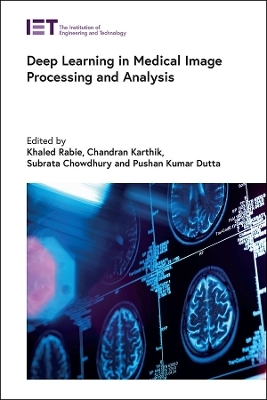
Deep Learning in Medical Image Processing and Analysis
Institution of Engineering and Technology (Verlag)
978-1-83953-793-6 (ISBN)
Medical images, in various formats, are used by clinicians to identify abnormalities or markers associated with certain conditions, such as cancers, diseases, abnormalities or other adverse health conditions. Deep learning algorithms use vast volumes of data to train the computer to recognise certain features in the images that are associated with the disease or condition that you wish to identify.
Whilst analysing the images by eye can take a lot of time, deep learning algorithms have the benefit of reviewing medical images at a faster rate than a human can, which aids the clinician, speeding up diagnoses and freeing up clinicians' time for other duties.
Deep Learning in Medical Image Processing and Analysis introduces the fundamentals of deep learning for biomedical image analysis for applications including ophthalmology, cancer detection and heart disease. The book considers the principles of multi-instance feature selection, swarm optimisation, parallel processing models, artificial neural networks, support vector machines, as well as their design and optimisation, in biomedical applications. Topics such as data security, patient confidentiality, effectiveness and reliability will also be discussed.
Written by an international team of experts, this edited book covers principles and applications for industry and academic researchers, scientists, engineers, developers, and designers in the fields of machine learning, deep learning, AI, image processing, signal processing, computer science or related fields. It will also be of interest to standards bodies and regulators, and clinicians using deep learning models.
Khaled Rabie is a reader at the Department of Engineering at Manchester Metropolitan University, UK. He is a senior member of the Institute of Electrical and Electronics Engineers (IEEE), a fellow of the UK Higher Education Academy and a fellow of the European Alliance for Innovation (EAI). He is an area editor of IEEE Wireless Communications Letters and an editor of IEEE Internet of Things Magazine. Chandran Karthik is an associate professor of Mechatronics Engineering at Jyothi Engineering College, India. He is a member of the Association for Computing Machinery (ACM), the ACM Special Interest Group on Computer Human Interaction (SIGCHI), and a senior member in IEEE, member in the IEEE Robotics and Automation Society. His research interests include medical robots, sensors, automation, machine learning and artificial intelligence-based optimization for robotics design. Subrata Chowdhury is with the Sreenivasa Institute of Technology and Management Studies, Chittoor, Andhra Pradesh, India. He has edited five books in association with the CRC Press and others. He has published more than 50 articles in international and reputed journals. His research interests include data mining, big data, machine learning, quantum computing, fuzzy logic, AI, edge computing, swarm intelligence, and healthcare. He is also an IEEE member. Pushan Kumar Dutta is an assistant professor at Amity University Kolkata with experience in book editing, proofreading, and research publication. He has published in IEEE conference and Scopus journals. He received the Best Young Faculty in Engineering award from Venus International Foundation Awards (2018) and the Young Researcher Award from IOSRD, India (2018). He is a senior member of IEEE and IET. His research interests include AI, machine ethics, and intelligent systems for biomedical applications.
Chapter 1: Diagnosing and imaging in oral pathology by use of artificial intelligence and deep learning
Chapter 2: Oral implantology with artificial intelligence and applications of image analysis by deep learning
Chapter 3: Review of machine learning algorithms for breast and lung cancer detection
Chapter 4: Deep learning for streamlining medical image processing
Chapter 5: Comparative analysis of lumpy skin disease detection using deep learning models
Chapter 6: Can AI-powered imaging be a replacement for radiologists?
Chapter 7: Healthcare multimedia data analysis algorithms tools and techniques
Chapter 8: Empirical mode fusion of MRI-PET images using deep convolutional neural networks
Chapter 9: A convolutional neural network for scoring of sleep stages from raw single-channel EEG signals
Chapter 10: Fundamentals, limitations, and the prospects of deep learning for biomedical image analysis
Chapter 11: Impact of machine learning and deep learning in medical image analysis
Chapter 12: Systemic review of deep learning techniques for high-dimensional medical image fusion
Chapter 13: Qualitative perception of a deep learning model in connection with malaria disease classification
Chapter 14: Analysis of preperimetric glaucoma using a deep learning classifier and CNN layer-automated perimetry
Chapter 15: Deep learning applications in ophthalmology - computer-aided diagnosis
Chapter 16: Brain tumor analyses adopting a deep learning classifier based on glioma, meningioma, and pituitary parameters
Chapter 17: Deep learning method on X-ray image super-resolution based on residual mode encoder-decoder network
Chapter 18: Melanoma skin cancer analysis using convolutional neural networks-based deep learning classification
Chapter 19: Deep learning applications in ophthalmology and computer-aided diagnostics
Chapter 20: Deep learning for biomedical image analysis in place of fundamentals, limitations, and prospects of deep learning for biomedical image analysis
| Erscheinungsdatum | 04.10.2023 |
|---|---|
| Reihe/Serie | Healthcare Technologies |
| Verlagsort | Stevenage |
| Sprache | englisch |
| Maße | 156 x 234 mm |
| Themenwelt | Informatik ► Theorie / Studium ► Künstliche Intelligenz / Robotik |
| Informatik ► Weitere Themen ► Bioinformatik | |
| Medizin / Pharmazie ► Medizinische Fachgebiete ► Radiologie / Bildgebende Verfahren | |
| ISBN-10 | 1-83953-793-0 / 1839537930 |
| ISBN-13 | 978-1-83953-793-6 / 9781839537936 |
| Zustand | Neuware |
| Haben Sie eine Frage zum Produkt? |
aus dem Bereich


